
Postage Stamps of the United States - 1925
Politics
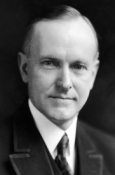
President
Calvin Coolidge
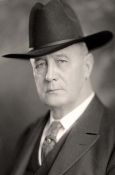
Postmaster General
Harry S. New
Music
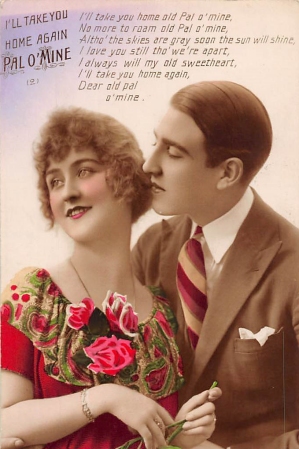
Click Control Above To Hear
1925 "I'll Take You Home Again"
Postage Rates
Domestic Letter Rate: 2¢ per oz.
Postal Card Rate: 1 ¢
Special Delivery Rate: 10¢
Postcard Rate: Jan. 1 - April 14: 1¢
Postcard Rate: April 15-Dec. 31: 2¢
Fractional Postage Rates Introduced (April 15): the rate for circulars was raised from 1¢ per oz. to 1½¢ per oz.
Air Mail Rate: 8¢ per oz. per zone - there were 3 zones (see: 1924 )
Although the Postal Service Act of Feb. 28, 1925 provided for a new "Private Contract Rate" of not less than 10¢ per oz.,
this service did not begin until 1926.
Registered Letter Fee: Jan. 1 - Apr. 14: 10¢ Apr. 15 - Dec. 31: 15¢(Postal Service Act of 1925)
Special Delivery Rate: Apr. 15, 1925 - 2-10 lbs. : 15¢ Over 10 lbs. : 20¢ (see below)
Special Handling Fee (Fourth Class): Apr. 15 - Dec. 31: 25¢(Postal Service Act of 1925) -
This gave a fourth class parcel the status of a first class letter (see below)
Stamps
The Lexington Concord Stamps
Flat Plate - Perforated 11 - 200 Subject Plates

1¢ Washington at Cambridge
15,615,000 issued
First Day: April 4, 1925

2¢ Battle at Lexington
26,596,600 issued
First Day: April 4, 1925

5¢ Minute Man
5,348,800 issued
First Day: April 4, 1925
The Lexington Concord Commemoratives were the first of many commemoratives issued to honor the 150th anniversary of events that surrounded America's War of Independence. Many of these commemoratives are what we now call the "2¢ reds".
Strangely, not all the stamps in this set honor the famous battle (or rather series of skirmishes) at Lexington and Concord. The one cent stamp depicts Washington assuming command of the American troops at Cambridge a full two months after the skirmishes. This is even more amazing in the fact that the skirmishes were immediately preceded by one of the most famous events in American history, namely the "midnight" ride of Paul Revere from Boston to Lexington and Concord. A congressman from Cambridge, Massachusetts convinced the Post Office Department that there was a link between Washington assuming command in Cambridge and the Lexington Concord battle. Most would agree that a stamp depicting the ride of Paul Revere would have been more appropriate, but politics prevailed.
The two cent and five cent stamps honored both Lexington and Concord; the two cent the actual battle at Lexington and the five cent the "Minute Man" statue at Concord.
All three stamps were placed on sale at the Philatelic Agency in Washington, D.C. and five Massachusetts cities that were an integral part of the Lexington Concord story: Lexington and Concord of course, as well as Boston, Cambridge, and Concord Junction. First Day covers are known from all six cities.
The Norse American Stamps
Flat Plate - Perforated 11 - 100 Subject Plates

1¢ Washington at Cambridge
15,615,000 issued
First Day: April 4, 1925

2¢ Battle at Lexington
26,596,600 issued
First Day: April 4, 1925
The Norse American commemoratives were a departure from other commemoratives of the time in two respects. They were printed in two colors, which in essence nearly doubled the time needed to print them, and they were printed in sheets of 100 stamps (10 x 10), rather than in sheets of 200 or even 400, again a more time intensive method of production. On the other hand, none of the stamps had straight edges and the two colored design created some of the more striking stamps of the early 20th century. The slow production limited the number of stamps produced, to the extent that the Norse American issue has the distinction of having the smallest quantity issued of any commemorative series ever issued by the U.S. These stamps were particularly popular in the upper Midwest, particularly western Wisconsin and Minnesota, where there were large populations of Norwegian descent. The limited quantities available led to grumbling, and that, along with the high cost of production, left a legacy that discouraged the future production of bi-colored stamps and to some extent issues publicizing current events. In this case they promoted the Norse American Centennial in St. Paul, Minnesota which began on June 8 of 1925.
The two cent stamp was issued to meet the regular mail rate and the five cent stamp to cover most foreign mail, including letters to Norway. The illustration on the two cent stamp is an artist's rendition of what the ship "Restaurationen" probably looked like based on a drawing of its sister ship. In 1825, the Restaurationen was the first ship to bring Norwegian immigrants to America.
The design on the five cent stamp is from a photograph of an exact size replica of an ancient Viking ship that sailed from Norway to Chicago in time for the Columbian Exposition of 1893. So faithful were the engravers to the photograph from which the stamp's design was made, that a flag of the United States is seen waving from the bow of the ship!
A great deal of care was taken to ensure the quality of the stamps in this set. Most copies are very well-centered and, as mentioned, there were no straight edges. Although many cities asked for the privilege of issuing the stamps on the First Day, only six cities were chosen. The stamps were issued May 18, 1925 at the Philatelic Agency in Washington, D.C., Decorah and Algona, Iowa and Minneapolis, St. Paul, and Benson, Minnesota.
The Special Delivery Postage Stamps of 1925
Flat Plate - Perf 11 - 200 Subject Plates
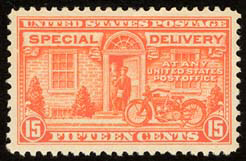
15¢ Orange Special Delivery
more than 17 million issued
First Day: April 11, 1925
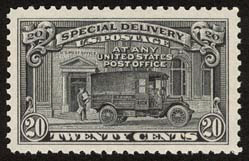
20¢ Black Special Delivery
about 30 million issued
First Day: April 25, 1925
In 1925, the postal rate for special delivery on parcels weighing between 2 and 10 lbs. was raised from 10¢ to 15¢ and for parcels weighing over 10 lbs. from 15¢ to 20¢. In a rush to get the new fifteen cent stamp to Post Offices, it was decided to simply alter the denomination and color of the existing stamp, the blue 10¢ stamp of 1922. Since the twenty cent rate could be met using two of the existing ten cent stamps, it was felt there was enough time to create a new design for the twenty cent rate before its issue, hence the new design with mail truck.
Both stamps were First Day issued only at the Philatelic Agency in Washington, D.C., but First Day Covers were already beginning to become popular in 1925 and these covers are not particularly scarce.
The Special Delivery Postage Stamps of 1925
Flat Plate - Perf 11 - 200 Subject Plates
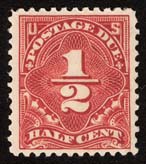
One Half Cent Postage Due
More than 32 million issued
First Day: April 13, 1925
In 1925, the postal rate for special delivery on parcels weighing between 2 and 10 lbs. was raised from 10¢ to 15¢ and for parcels weighing over 10 lbs. from 15¢ to 20¢. In a rush to get the new fifteen cent stamp to Post Offices, it was decided to simply alter the denomination and color of the existing stamp, the blue 10¢ stamp of 1922. Since the twenty cent rate could be met using two of the existing ten cent stamps, it was felt there was enough time to create a new design for the twenty cent rate before its issue, hence the new design with mail truck.
Both stamps were First Day issued only at the Philatelic Agency in Washington, D.C., but First Day Covers were already beginning to become popular in 1925 and these covers are not particularly scarce.
The Special Handling Postage Stamp of 1925
Flat Plate - Perf 11 - 200 Subject Plates
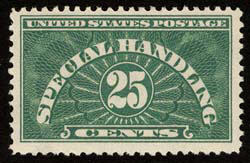
25¢ Special Handling Stamp
less than 24 million issued
First Day: April 11, 1925
Do you ever really take the time to think about why a particular stamp may have been issued? The Number catalog explains the use of this stamp in the following manner: "The Postal Service Act, approved February 28, 1925, provided for a special handling stamp of the 25-cent denomination for use on fourth-class mail matter, which would secure for such mail the expeditious handling accorded to mail matter of the first class."
This hardly tells the whole story of this interesting stamp, lost in the back of the book and hidden behind its Parcel Post and Special Delivery brethren. Number uses the letter "Q" to designate Parcel Post stamps and "E" to designate Special Delivery stamps and thus "QE" for the Special Handling stamps. Perhaps the letter "E" is somewhat misleading. Although the Special Handling stamp is a "special delivery" handling fee for parcels, the special delivery was special only in the sense that a parcel with this fee paid was accorded first class status - not the Special Delivery status that was given correspondence and parcels with normal Special Delivery stamps attached. Thus a parcel with the Special Handling fee paid would be delivered with the same speed and at the same delivery hours as a normal first class letter. Initially, this 25¢ fee was required for certain fourth-class parcels in addition to the normal Special Delivery fee, if expedited service was required above normal delivery. After July 1, 1928, the special handling fee was no longer required in addition to the special delivery fee, that is, if the special delivery fee was paid, the special handling fee was no longer required.
When the Special Handling stamp was authorized, some of the parcel matter contained live animals, such as baby chicks, queen bees and, these were specifically mentioned by the Post Office, baby alligators. If the packages were delivered with the same speed as normal parcel matter, the animals would perish. For this reason, special handling of certain parcels was not an option and collecting this extra fee helped to defray some of the added expense. Although the special handling fee was required for such fragile cargo, the Special Handling stamp itself was not required, it was issued to indicate that the added fee had been paid and to emphasize the new service. Although the last Special Handling stamps were printed in 1955, the fee is still required today for "unusual items that need to be handled specially ..." see USPS Special Handling for more.
The 25¢ Special Handling stamps were never printed using the "dry" method. The dark green 25¢ stamps are the early printings, listed in Number as "QE4". The chronology of the Special Handling stamps is first the 25¢ dark green stamp (1925), then the yellow green 25¢ (print run of 6 days, Jan. 14-19, 1928). followed by the 10¢, 15¢, and 20¢ stamp wet printings (June,1928), and finally the dry printings of the 10¢, 15¢, and 20¢ stamps (1955). For a fuller discussion of this, see the 1928 page.

This first special handling stamp, QE4, has a very collectible variety, in which the "A" and second "T" of "STATES" are joined, and an even more collectible variety in which both the "A" and "T" of "STATES" are joined and the "T" and "A" of "POSTAGE" are joined. Number does not distinguish the scarcity of this second variety, but there is an interesting article, by Robert G. Rufe, on these "relief breaks" in the Oct. 2007 and Oct. 2008 issues of the United States Specialist, in which the second variety is described as being more than thirty times scarcer than the first.
Also See Regular Issues of 1925
The following postage stamp varieties were first issued by the U.S. in 1925
Ordinary issue
Flat Plate - Perf 11 unless otherwise noted - Designer: Claire Aubrey Huston
Number 551 - ½¢ Nathan Hale - FDC: 4/4/1925
Engravers: J. Eissler (vignette) - E. Hall (frame, lettering) - J. Benzing (scrolls, ribbon) - E. Weeks (numerals)
Number 553 - 1½¢ Harding - FDC: 3/19/1925
Engravers: F. Pauling (vignette) - E. Hall (frame, lettering) - Benzing (scrolls, ribbon), Weeks (numerals)
Number 576 - 1½¢ Harding Flat Plate Imperforate - First Day: 4/4/1925
Number 582 - 1½¢ Harding rotary perf 10 - First Day: 3/19/1925
Number 584 - 3¢ Lincoln rotary perf 10 - First Day: 8/1/1925
Number 585 - 4¢ Martha Washington rotary perf 10 - First Day:: 4/4/1925
Number 586 - 5¢ Theodore Roosevelt rotary perf 10 - First Day: 4/4/1925
Number 587 - 6¢ Garfield rotary perf 10 - First Day: 4/4/1925
Number 591 - 10¢ Monroe rotary perf 10 - First Day: 6/8/1925
Number 598 - 1½¢ Harding rotary coil perf 10 vertically - First Day: 3/19/1925
Number 605 - 1½¢ Harding rotary coil perf 10 horizontally - First Day: 5/9/1925
Number 623 - 17¢ Woodrow Wilson - FDC: 12/28/1925
Engravers: John Eissler (vignette) - Edward M. Hall (frame, lettering) - J. C. Benzing (scrolls)
Commemoratives
Number 617 - 1¢ Lexington Concord
Designer: C. A. Huston - Engravers: Frederick Pauling (vignette) - Benzing (frame) - Weeks (lettering, numerals)
Number 618 - 2¢ Lexington Concord
Designer: Huston - Engravers: Schofield (vignette) - Benzing (frame) - Weeks (lettering and numerals)
Number 619 - 5¢ Lexington Concord
Designer: C. Aubrey Huston - Engravers: J. C. Benzing (frame, vignette) - E. M. Weeks (lettering, numerals)
Number 620 - 2¢ Norse American
Designer: Clair Aubrey Huston - Engravers: E. J. Hein (vignette) - W. B. Wells (frame) - E. M. Hall (lettering)
Number 621 - 5¢ Norse American
Designer: C. A. Huston - Engravers: Joachim C. Benzing (vignette, frame) - Edward M. Weeks (lettering)
Air Mail
No new varieties of the Air Mail stamps were issued in 1925
Special Delivery
Flat Plate perf 11
Number E13 - Orange 15¢ Motorcycle
Designer: C. Huston - Engravers: L. S. Schofield (vignette, frame) - E. Weeks & E. M. Hall (numerals, lettering)
Number E14 - Black 20¢ Truck
Designer: C. Huston -Engravers: Louis Schofield (vignette, frame) - E. Weeks & E. Hall (numerals, lettering)
Postage Dues
Number J68 - The ½¢ Flat Plate Postage Due - First Day: 4/13/1925
Special Handling
Note: Number now lists these as they properly should be, the dark green stamp (1925) as QE4 and the yellow green stamp (1928) as QE4a
Number QE4 - 25¢ Dark Green Special Handling - Wet Printing
Designer: Clair Aubrey Huston - Engraver: Edward M. Hall





